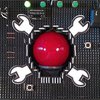This is the plan. I say plan... See it more as a brainfart that requires ALOT of actual thought:
An Arduino Uno will receive input from the Keyboard/Mouse (either using Host Shield or using PS/2 Devices and the PS/2 library.
The Uno will also act as an i2c master.
An Arduino Pro Micro clone (based on the Atmega32u4 chip) will be added as a slave for each Machine that needs controlling.
Each slave will carry the code to provide key strokes for all platforms (Win, Mac, Android etc plus custom). A switch added to the slave can determine mode.
The master will monitor the PS2 inputs and redirect the keystokes and mouse data to the relative slave when a key combo is entered; The Pro Micros will be recognised as HID devices and pass the received input to the machine.
In order to make this modular I am keen to design a case that features a backplane of sorts that carries the i2c lines, and then the Pro Micros can be connected by simply plugging into this backplane. This will all the switch to be easily expandable.
 Craig Hissett
Craig Hissett

Some input about video switching:
I've built an 12 port RGB switch box + HomeCinema automation device for my retro video game collection a few years ago, using the NXP CBT3244A (I thing I used a TI variant of it IIRC) and 74595 shift registers.
I got the idea from [this BenHeck article](https://www.engadget.com/2007/03/13/how-to-make-a-solid-state-a-v-switcher/).
It should be trivial to add one of those chips to each of the Micros, or wire the USB / PS/2 bus into it as well and drop the Micros completely.
Hit me up, if you want to know more about anything I mentioned above.
(Maybe it helps someone else, if Craig doesn't want to / can't develop this thing further)